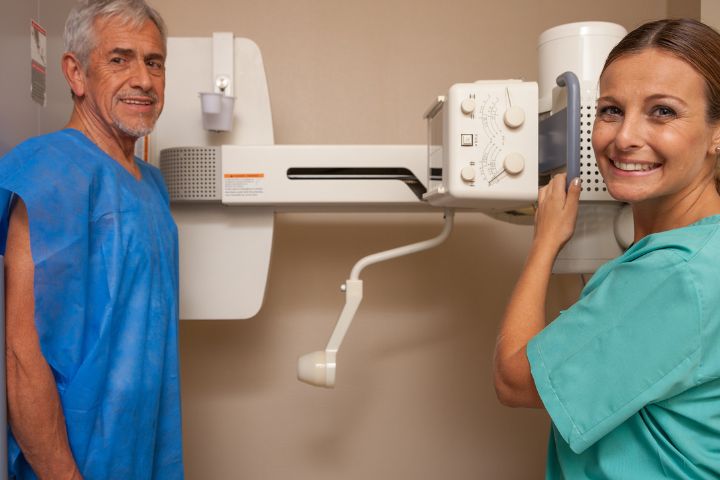If you’re considering pursuing a radiologic technologist education you’re making an excellent choice! They provide doctors with vital patient information (in the form of imaging scans) needed to make diagnoses that can save lives. Aside from being an essential part of the healthcare team, there are many good reasons to get an education and start a career in radiology technology.
You might be wondering about radiology technician careers and what they entail. Well, first, these professionals most commonly work under the occupational title of a Radiologic Technologist or a Radiographer. While it’s possible some may refer to them as Radiology Technicians, the industry prefers the terms Radiologic Technologist and/or Radiographer. Radiologic technologist careers are challenging yet rewarding for those looking to join the healthcare field and help patients. The good news is you can graduate from an associate degree program in just two years. Read on to learn about basic requirements for your radiologic technologist school and what to expect from your education and training.
Find out what Dorsey College has to offer!
What to expect from your radiologic technologist education
The classes you take for your career can cover many topics. Some of these topics could be the basics of radiographic technology, how to care for patients safely and effectively, how to follow safety and regulatory rules, how to do imaging scans on different parts of the body, and how to analyze images and manage quality. Some of these topics may include:
- Terminology, principles, and applications of digital technology
- Image quality and radiation safety practices
- Legal and ethical considerations/issues
- Patient assessment, infection control, emergency and safety procedures, and patient interaction skills
- Exposure to the knowledge base needed and the opportunity to obtain practical experience applying that knowledge to perform imaging procedures on various parts of the body
- An overview of the principles of radiation protection, including the responsibilities of the radiographer for patients, personnel, and the public
- Radiation health and safety requirements of federal and state regulatory agencies, accreditation agencies, and health care organizations
- Establishing a basis for analyzing radiographic images, the importance of optimal imaging standards, discussion of a problem-solving technique for image evaluation, and the factors that can affect image quality
- Introduction to basic knowledge of quality control and federal regulation standards
- Comprehensive content review, designed to prepare students to challenge the ARRT exam in radiography [1]
Associate degree programs in this specialized area include both general education courses and courses that are specific to the career. General education classes can help students build a strong foundation before they start taking classes more specific to the radiology career.
Applying what you have learned
A clinical training component is often a part of training programs. Clinical training allows students to use the skills and knowledge they learned in the classroom in real-world situations. Radiologic technologists work directly with patients, so it’s important to choose a program that has a strong hands-on component and gives you many chances to not only learn your new skills but also master them through practice.
How long is a radiologic technologist school?
Most radiologic technologists go to school for two years to get an associate degree in radiologic technology before they start working. Students may be able to take the national exam for a certification after they get their degree. The American Registry of Radiologic Technologists (ARRT) is in charge of this test.
What are the basic requirements to enroll in rad tech school?
A high school diploma or a GED is needed to get into an associate degree program. Other requirements, like your high school GPA, can vary from school to school. Applicants usually send transcripts and other documents to the college or university of their choice when they fill out an application. Be sure to check with the schools you are considering to see what their specific admissions requirements are for their program.
Are you ready to become a radiologic technologist?
Though every school is unique, most colleges have the same basic requirements to be considered for admission. In general, you must:
- Complete an admissions application
- Be at least 18 years old
- Have a high school diploma or equivalent
- Fill out financial information
- Submit official transcripts
- Submit supporting documents/materials for admission
You may also need to meet with an admissions representative to discuss your application and the documents you sent with it, as well as make a plan based on your test scores and goals.
Taking a step towards your future with Dorsey College
When students choose Dorsey College for their radiologic technologist education, they will get both classroom and hands-on experience. Our program has been carefully built to include clinical training, this method allows students to use the things they are learning in a real-world setting. At Dorsey College, we are dedicated to helping our students. We do this by giving them thorough training and helping them get started in their new career. If you want to become a radiologic technologist in Michigan, contact Dorsey College today to learn how to start training in the Associate of Applied Science in Radiologic Technology education program.
Sources:

